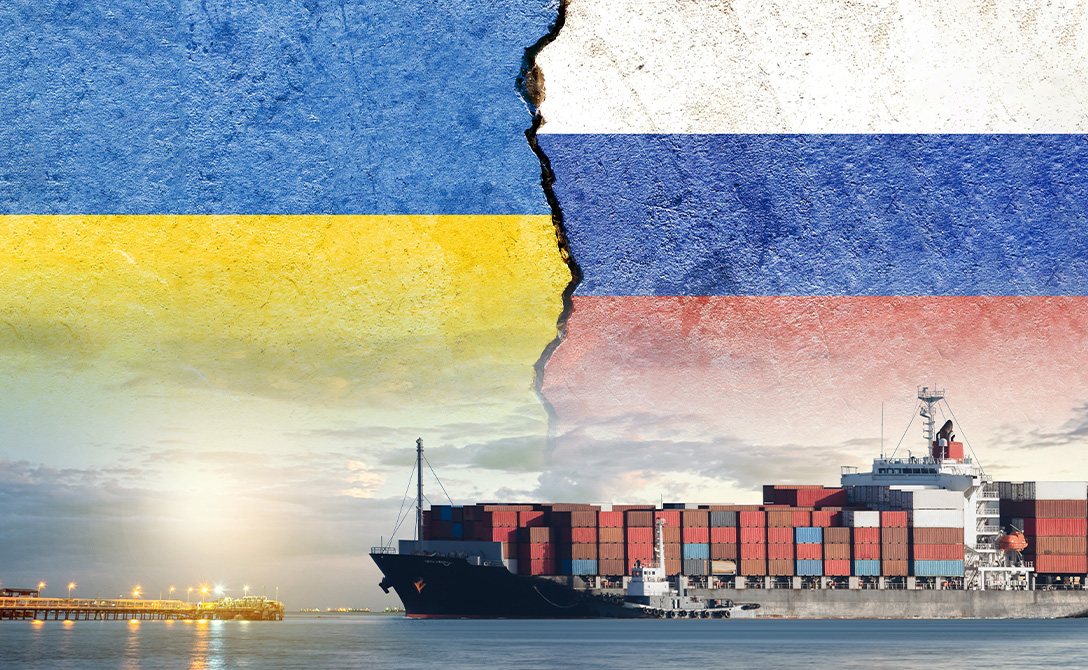
The Russia-Ukraine war has had a massive impact on global networks in terms of trade and goods distribution. It has created transportation bottlenecks, leading to a shortage of key products. The results can be seen across multiple industries, from energy production to consumer goods.
Here's a look at how some specific industries have been disrupted by the war, resulting in higher prices and reduced supply
Agriculture: According to the United Nations Food and Agricultural Organization, these are the agricultural goods that have been most affected:
- Sunflower oil. Ukraine is the leading producer of sunflower oil, with nearly 13 million tons produced per year, followed by Russia. Together, these two countries account for 50% of all sunflower oil production worldwide.
- Wheat. Russia and Ukraine contribute approximately 30% of the global wheat supply.
- Barley. Russia and Ukraine are first and fourth, respectively, in terms of barley production.
Semiconductors: Ukraine provides half of the world's neon gas, which is vital to the semiconductor industry. The lack of this key manufacturing element has considerably impacted the production capacity of companies such as ASML, Samsung, Intel, and TSMC.
Energy: Global oil and gas industries are experiencing a shortage of supplies because major companies like British Petroleum have a large stake in Russian firms such as Rosneft. These negative consequences are likely to persist.
Transportation: Transportation bottlenecks have led to a surge in oil and gas prices, requiring alternative routes that are more expensive. Carriers such as UPS, FedEx and DHL have pulled out of the two countries. Furthermore, Russian airspace is blocked, and waterways face port congestion, with container shortages and surcharges.
Alternative Supply Chain Strategies for Industries Impacted by the War in Ukraine
Agricultural requirements can be met by growing crops locally or importing them from other nations: wheat from China, India, and the U.S.; barley from Australia and Canada, and sunflowers from Argentina and China.
Large semiconductor companies are striving to become more self-reliant by utilizing near-shore manufacturing to fulfill their needs for semiconductors. Intel plans to build two factories in Ohio, and ASML intends to set up additional manufacturing units in the U.S. In addition, China can serve as a substitute supplier of neon gas for the semiconductor industry.
In the energy sector, some countries are looking to nuclear power as an alternative source of supply. Further, oil and natural gas can be obtained from the U.S. and Saudi Arabia, and coal can be imported from the U.S., Indonesia, India, Australia, and China.
In transportation, the use of alternative air routes can help ensure continuity of supply during challenging times. They include air travel over the North or South Poles through the Middle East, employing Kazakhstan as a stopover on the southern route, using airports in Abu Dhabi and Dubai for accommodating additional air traffic in the Middle East, and diverting cargo on the China-Europe rail route through southern Russia and Siberia.
All of these options necessitate relying on other countries, which presents physical barriers, new trade regulations and time constraints. For example, the flight duration between the UK and India or Pakistan will increase while circumventing Russia. In addition, rising fuel prices add expense to the commute. And some of those alternatives won’t suffice for transporting perishable goods.
The war in Ukraine is disrupting supply chains spanning multiple regions, but it needn’t lead to a halt in operations. To prevent major interruptions in trade flows, businesses should develop supply chain risk mitigation strategies backed by analytics to navigate this shifting landscape with confidence.
Transform Your Supply Chain Strategy with Tredence's Predictive Supply Risk Management
Addressing global disruptions with new supply chain risk mitigation strategies
Delivery promise optimization: Since air travel has become increasingly expensive due to Russia’s airspace prohibition, faster deliveries to keep customers happy are costing significantly more than in the past. As a result, it’s more crucial than ever to set the right expectations with customers, and charge appropriately while maintaining customer satisfaction. Supply chain risk mitigation strategies must include accurate delivery promises.
The first step is to assess the impact of these new constraints on overall delivery time. The next is to update delivery promises with high accuracy, instead of apologizing for the delayed delivery and expecting the customer to understand. Finally, using an artificial intelligence algorithm to analyze in real time the factors that cause delays is essential. For example, when a customer places an order, such supply chain analytics models can provide updated and precise delivery times.
To execute this, the organization should have access to data on historical lead times, vendor lead times from service-level agreements, the origins of all parties involved in shipping product, and customer locations. Data that can be generated or extracted includes natural or man-made disruptions, port congestion and air-route traffic, geopolitical tensions and actual transit time, with traffic and other blockages taken into consideration.
Transportation optimization: Although existing transportation management systems might determine the right mix of road, rail, ocean and air transport, they’re constrained by years-old contracts and agreements. An AI-driven optimization algorithm can quickly make recommendations to fix the gaps. It can also suggest consolidation opportunities to move finished and unfinished goods in the most cost- and time-effective manner.
To make this possible, the organization should have readily available data on the current load profile across all modes of transport, the current rate card, origin and destination pairs, and carrier capacities. Their supply chain risk mitigation plan must have data that can be generated or extracted, including the demand forecast and consolidation scenarios.
Inventory planning: Stockpiling inventory can help resolve short-term supply chain disruptions. With a smart inventory management tool, companies can examine current inventory levels, model their freshness and forecast delays in the lead time for merchandise coming from global suppliers. Further, recalibration of safety stock and cycle-stock levels can balance the cost of holding more inventory and stockout losses.
Finally, a quick patch of the AI-driven optimization engine over the existing supply chain planning tool can help make these decisions based on inputs such as the current global scenario, port congestion, airway restrictions and global supplies shortage.
To make this happen, the organization should have data on existing inventory levels. Data that can be generated or extracted includes the demand forecast; lead-time variability, accounting for natural or man-made disruptions; port congestion, air-route traffic, and geopolitical tensions. Supply chain risk mitigation in inventory planning ensures that stock levels are managed effectively.
Production planning: Production can maximize the output of finished goods based on the availability and expected delay in some raw materials. Manufacturing and consumer goods companies that have managed to stockpile raw materials and components might need to adjust their production output in anticipation of raw material shortages. Further, organizations still waiting for raw materials should adjust their production schedule to make the most of available time and resources.
Relevant data that should be available to the organization includes the real-time production plan, raw material inventory, and the production plant’s capacity and constraints. Data that can be generated or extracted includes the demand forecast, supply risk index based on natural or man-made disruptions, and a control tower for end-to-end supply chain visibility.
Since supplies are at higher risk of arriving late or not arriving at all, having good visibility into the entire supply chain beyond tier 1 suppliers is now crucial. With this level of dependency on tier 2 and other suppliers, it’s important to have a supply chain control tower to provide end-to-end visibility, from the status of sourcing of raw materials to last-mile delivery of finished product. The control tower, part of your supply chain risk mitigation tools, will not only provide descriptive views of key performance indicators, but also generate predictive and prescriptive insights to optimize current scenarios.
Though the current conflict in Ukraine is primarily between two nations, it has impacted businesses and supply chains across the globe. And, because such conflicts often occur without warning, there’s little time to adjust business practices accordingly. That’s why companies must turn to tools that can detect and respond to disruptive trends early. Smart recommendation engines can provide executives with peace of mind, and keep business moving forward when a disruption occurs.
Shubhankit Verma is Senior Manager, Supply Chain Practice, and Pradnya Shivsharan is a supply chain consultant, with Tredence Inc.

AUTHOR - FOLLOW
Shubhankit Verma
Senior Manager, Supply Chain Practice
Topic Tags
Next Topic
How Retailers Can Harness the Full Potential of Enterprise Data Analytics
Next Topic




